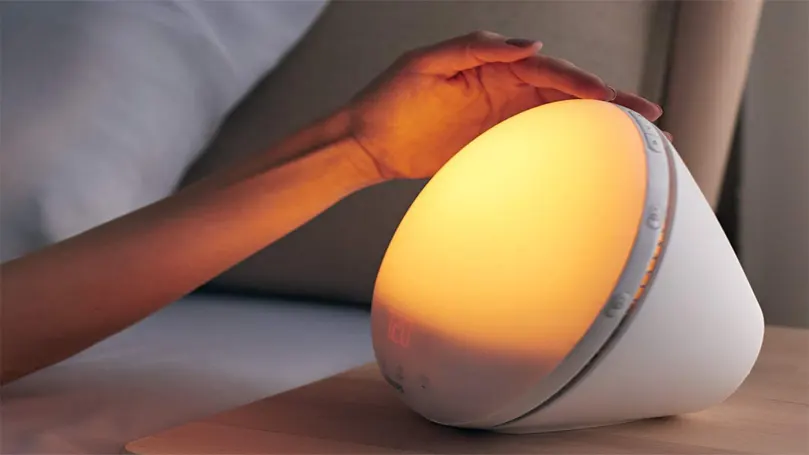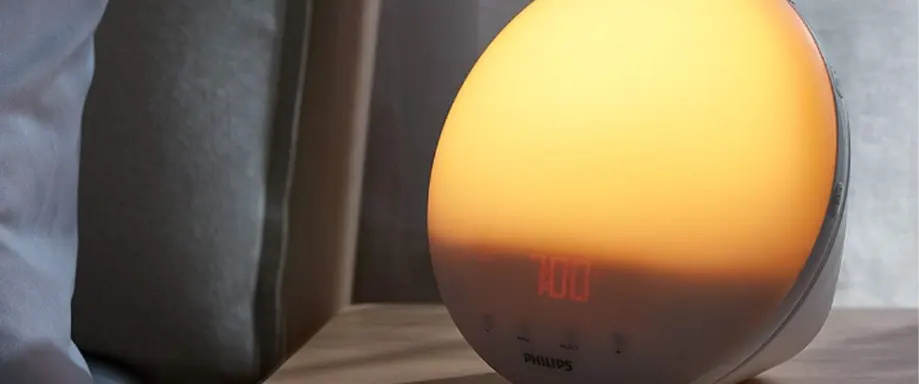Advantages



Disadvantages

Who is Philips Wake Up Light for?
Before we can tell you who is this one for – we have to tell you what this one is.
Philips Wake Up Light is an alarm clock that uses light to help you wake up. The light is gradually increased before your alarm goes off, which is supposed to make it easier for you to get out of bed.
In short – Philips Wake Up Light is for those who have trouble waking up in the morning, or those who simply want to start their day in a more pleasant way.
On a more detailed note, this one's for:
- People who sleep with blackout curtains
- People who have trouble getting up in the morning
- People who need to get up early during dark, winter months
- People who are tired of their old alarm clock
- People who appreciate cool gadgets.
Features you should know about Philips Wake Up Light
You've probably seen how this one's priced compared to the other light alarm clocks, and you may be wondering – why is it this bloody expensive. Well, there are a few features that set this one apart.
Let's check them out.
This one won't just help you get up – it'll also help you fall asleep.
A simulated sunset feature is a form of light therapy. It slowly dims the light over a set period, until it's turned off completely. This dimming light feature is designed to help you relax and get ready for sleep and you won't have to set it manually. If your room is dark – the light will automatically completely shut off.
On the other hand, the sunrise feature gradually gets brighter over the same time period, until it reaches its maximum brightness. Your room will first turn red, then gradually go through shades of orange until it's fully lit with bright yellow (almost white) light. The sunrise will typically last for half an hour, but there are certain simulations that allow for 20 to 40-minute simulated sunrises.
Both of these can and will be followed with sound, both soothing and “alarming”, although the latter is definitely not how we'd describe the wake-up sounds, but more on those in a second.
Philips Wake Up Light has 7 different, natural sounds that can wake you up. You can choose from the following seven:
- Forest day-forest birds
- Buddha
- Yoga
- Ocean Waves
- Nepal Bowls
- Morning Alps
- Summer Lake.
There is also an FM radio if you want to wake up to music.
Both of these will gradually turn up over the course of a minute and a half, to gently and naturally (as naturally as possible) wake you up.
With 20 brightness options, with the brightest one reaching 300 Lux, you can set it up however you want it.
Now, not everyone is the same, and some people may prefer a dim light while others might want something that's practically blinding, so 300 Lux may not mean anything to some of you, but still, it's good knowing you can make it very bright.
Of course, you will be the one to set a schedule for the light, so it reaches certain peak brightness at a certain time – whether that's maximum or not.
All in all, with 20 brightness options – everyone will be able to find the sweet spot for themselves.
This one's also packed with loads of additional features. It has an FM radio, which you can listen to both during the day and at night, if that's something that helps you relax.
There's also a snooze function in case you need just a few more minutes. Just tap the top of the light and you'll get 9 more minutes before it goes off again.
Another feature is the USB charging port on the back. You can use it to charge your phone or any other devices overnight. This way, your alarm clock will double as a nightstand charger.
Last but not least – there's an auto-dim display. This means that when the room is dark, the display will automatically dim itself so it doesn't bother you while you're sleeping. You can, of course, turn this off if you want, although we don't see why you would ever do that.
Review of the Philips Wake Up Light

Alright, so, what do we think so far? Is this just an overpriced lamp that happens to have an alarm clock?
Of course not. In fact, this can't even be used as a lamp or a useful light fixture, so if anyone says so, don't take their words too seriously.
What this is, however, is an alarm clock that's specifically designed to make you wake up feeling refreshed, well-rested and energized. It does so by gradually increasing the wake-up lights and sound until you're fully awake. And it does a great job at it. Seriously, when it comes to sunrise and sunset simulations – this one kicks every other light alarm clock out of the park. It's simply marvellous.
Of course, some might say that there are better and more natural ways to wake up, but if you're someone who struggles with waking up early, or just hates the sound of alarm clocks – this might be a game-changer for you.
It's not perfect, of course. The light isn't completely natural, nor is the sound. But it's as close as you can get, and it definitely works. And sure, the speaker is not all that great and the sounds don't sound as natural as they should, especially considering the price tag, but do you really care about an alarm sound clarity and true-to-life feel? We didn't think so.
Now, there are other aspects about this one that are both great and not as great, but more on those in a minute. Overall, if you're looking for an alarm clock that will make early mornings a bit more bearable – this is the one we recommend.
KEY FEATURES:
- Wattage: 16.5 W
- Voltage: 100/240 V
- Weight: 730 g
- Light colour: Red, orange, yellow
- Lamp: LED
- Brightness settings: 20
- Light intensity: 300 Lux
- Number of sounds: 7
- Snooze: Yes, 9 minutes
- Smartphone charger: Yes
- Radio: FM
- Warranty: No
What we like about Philips Wake Up Light
- Arguably the best light alarm clock on the UK market – even at this price point
- 20 different brightness options are more than enough for you to find the one for you
- Light transitions from bright to dim and the other way around absolutely flawlessly
- The non-slip bottom and sturdy build make this one pretty hard to knock over when you go for the snooze
- Speaking of snooze, the entire device is touch-sensitive so you can just tap the alarm to get an extra nine minutes of sleep
- It has been clinically proven to work, by “independent science facilities”
- It has several extra features that we find more than useful – like a smartphone charger. It's far from fast, but it'll get the job done in a few hours. Also, why use two sockets when you can use one? Just keep the cable plugged in and charge your phone each night.
What we didn’t like about Philips Wake Up Light
- You could get a very similar product for literally five times less
- It's only an FM radio. It's not DAB radio. All in all, good luck with catching a decently-sounding FM radio station. Also, the speaker's there but you can't stream music from your phone. Another missed opportunity
- The “natural sounds” don't really sound natural, but this is truly a minor complaint. They're more than passable
- You will need to use a manual if you want to get around this one without a headache There are some counter-intuitive shortcuts you'll have to learn from the manual because you'll never figure them out by yourself. And quite frankly, they don't even have to be there
- The button placement is bad. Truly. It's hard to hit them when you're drowsy and half-asleep. The only upside is that the entire clock is very sturdy and stable so you're not constantly knocking this expensive gadget over
- You can set two alarms, but you can't set them for each individual day. So, if you want to sleep in on a Sunday, you'll have to manually turn the alarm off.
The common problems with Philips Wake Up Light & how to solve them
Most of the problems we've listed above are “first-world” problems. To be fair, any problem with a light therapy alarm clock is a first-world problem. But then again, when you're paying a premium rate, you kind of have to expect as much as we did.
But, all these small issues aside, the one that annoys us the most are the buttons (there are 15 of them) and how complicated this thing is. So, here's our rant. Philips, hear us out on this one. You've made the device touch-sensitive. How about a double-tap to turn the alarm off but leave it on for the next day? Or a swipe? Why do we have to fish for the buttons with our eyes closed? Why is one button for “turn off but leave on for tomorrow” and the other one for “turn off for good”? This is a major oversight that could've been solved with little to no effort on your end.
You know what's worse? There is a double-tap function. It's used to turn on the Midnight light (wake up the device) so you can see the time in the middle of the night. And, to add salt to the wound, it's double-tap again if you want to turn it off. As far as we're concerned, it should turn off automatically.
Also, do we really need to press both alarm buttons to change the duration of the natural sunrise simulation? Why can't we access that from the menu? Or better yet – why isn't there an app for this thing? That would've been beyond awesome.
Other than that, it's all good.
What makes this product better than some other similar ones?
On a more positive note, this one's astounding at what it's supposed to do. If you're looking for a light therapy alarm clock, this is the one to get. It's more expensive than most, but it comes with a few features that make it worth the money.
The first one is, of course, the light itself. The light transitions are smooth and gentle, which is what we'd expect from LED lights. Even if you were to lie awake and just look at your walls, you'd think the sun is actually rising.
The second feature is sound. Well, the speaker. The sound quality is decent, and the speaker is powerful enough to fill a small room, but still not as overpowering so it wakes you up like a bucket of water. What's more important is how gradually it's powering up so as not to disturb you, but instead gently wake you up.
The third feature is the build quality. The materials used are of high quality, and it shows.
Finally, the phone charger's a neat addition. It's USB-A, so most of the cables you have lying around will fit. As we've said, it's not super fast, it's not wireless, but you're going to bed – we'd actually recommend not using a fast charger in that situation.
All in all – we'd say get this one if you need it. It'll get the job done.
How we tested the product

So, you want to know how did we test this product.
Well, let's just say we had a lot of fun with this not-your-regular alarm clock.
We started by reading the instructions carefully. We wanted to make sure we understood how the alarm clock worked. And, even though the buttons are marked and surprisingly intuitive, we knew people are vocal about them so we had to really dial everything in.
After that, we placed the alarm clock on our nightstand and plugged it in. We set the time and date and then programmed the first alarm.
And the second, just to make sure it works. We also changed the light settings and sound settings to get a feel for how everything worked.
Then, we tested how smoothly the light transitioned and how bright it got. We also played with the sound to see how gradually it increased in volume.
After that, we set the alarm for the next day and simply went to bed. We wanted to see how well the alarm clock would wake us up.
And, finally, we tried to use it as a night light. We turned off the lights and used the alarm clock's light to see if we could still read for a few minutes, even though Philips is quite outspoken about this one not being a “light fixture”. However, you could get a few minutes of reading in, no problem.
Overall impressions of the product after the testing
In our opinion, the Philips SmartSleep Wake Up Light is a great light therapy alarm clock. It's worth the money because it does what it's supposed to do.
We've experienced no problems with the light or the sound. The light transitions are smooth and gentle, and the sound gradually increases in volume, which is perfect for waking up. Brilliant, truly.
As for the trinkets, a phone charger is a neat addition and it works with any phone. The radio's underwhelming, but it's there. If you happen to live nearby a station – you'll make something of it.
However, due to the now already infamous buttons – we can't say this one's perfect. We found it to be particularly annoying in the morning, and despite our best efforts – we couldn't get over the fact that some things could've been executed in a much better way.
So, for that reason and that reason only, we give this product a rating of 8 out of 10.
Spread the word
FAQs about your Philips Wake Up Light
In the end, let's just answer a few FAQs.
From what we've learned, we see this wake-up light alarm clock lasting for years – possibly over a decade.
All you need to do is plug it in and it'll boot up. As for setting the alarm, the brightness, and choosing the alarm sounds – you'll probably be better off with an instruction manual that comes in a box.
The peak brightness of Philips SmartSleep Wake Up light is 300 Lux. So, very bright.














There are no comments yet
"*" indicates required fields